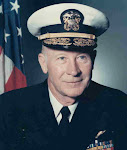Gentleman Jack
Today we celebrate the One Hundredth Birthday of Jack Arnold. Sadly, Uncle Jack passed away on 8 December 2007, a little over a month after his 95th birthday and the day after Pearl Harbor Day.
Jack Arnold was born on November 3, 1912, in Gainesville, Florida.
He entered the U.S. Naval Academy in June 1930, and graduated with a commission as an Ensign in the U.S. Navy on May 31, 1934.
His first assignment was aboard the battleship USS Arizona (BB-39) from June 1934 to December 1936, followed by flight training at NAS Pensacola, Florida, where he received his designation as a Naval Aviator on December 10, 1937.
Lt Arnold then served as a TBD Devastator pilot with Torpedo Squadron SIX (VT-6) aboard the aircraft carrier USS Enterprise (CV-6) from January 1938 to June 1939, followed by service as an SOC-1 Seagull floatplane pilot aboard the light cruiser USS Savannah (CL-42) from June 1939 to May 1941.
His next assignment was at NAS Pearl Harbor, Hawaii, where he served as an Engineering Test Pilot from May 1941 to March 1943. During this time, Lt Arnold was at Pearl Harbor during the Japanese attack on December 7, 1941, and managed to shoot down a Japanese torpedo plane with a Browning Automatic Rifle (BAR) from the ground. The high point of that tour was meeting and marrying Muriel Katherine McChesney, who he made Mrs. Muriel K. Arnold on 19 January 1942.
After completing additional training at NAS Jacksonville, and NAS Fort Lauderdale, Florida, he served as Commanding Officer of Torpedo Squadron TWO (VT-2) from June 1943 to May 1944, flying off the aircraft carrier USS Hornet (CV-12) from March to May 1944, where he was credited with the destruction of 2 enemy aircraft in aerial combat.
CDR Arnold next served as Commander of Carrier Air Group TWO (CVG-2) aboard the USS Hornet from May to September 1944, where he destroyed another 2 enemy aircraft while flying an F6F Hellcat fighter. These last 2 air victories, gave him a total of 5 enemy aircraft destroyed, but ace status was denied him because the first aircraft was shot down from the ground.
He then served in the Office of the Chief of Naval Operations for Air from September 1944 to December 1947, followed by service as Air Officer aboard the aircraft carrier USS Boxer (CV-21) from December 1947 to August 1948.
His next assignment was as Executive Assistant to the Overhaul and Repair Officer at NAS San Diego, California, from August 1948 to August 1950, and then completed his Master's degree at Harvard University from August 1950 to June 1952.
Capt Arnold served as the Bureau of Aeronautics General Representative for the Western District in Los Angeles, California, from June 1952 to June 1953, and then as the Bureau of Aeronautics Representative in Burbank, California, from June 1953 to February 1955.
His next assignment was as Director of the Contracts Division with the Bureau of Aeronautics at the Pentagon from February 1955 to June 1958, followed by service as Commanding Officer of the Naval Air Material Center at Philadelphia, Pennsylvania, from June 1958 to September 1961.
Adm Arnold served as Assistant Chief of Production and Quality Control with the Bureau of Weapons at the Pentagon from September 1961 to November 1963, and then as Force Material Officer on the staff of the Commander of Naval Air Force, Pacific Fleet, from November 1963 to August 1966.
His next assignment was as Deputy Chief of Naval Material for Logistics Support at the Pentagon from August 1966 to August 1967, followed by service as Vice Chief of Naval Material at the Pentagon from August 1967 to June 1970.
Adm Arnold's final assignment was as Chief of Naval Material in the Pentagon from June 1970 until his retirement from the Navy on December 1, 1971.
Jack and Muriel were married for more than 63 years. They had no children, but were extremely close to their 28 nieces and nephews. Jack Arnold died on December 8, 2007, and his and Muriel's bodies are in-urned at Fort Rosecrans National Cemetery in San Diego, California.
Jack's Navy Cross Citation reads:
For extraordinary heroism as Group Commander and Flight Leader in Fighter-Bombing Squadron TWO, attached to the U.S.S. HORNET, during action against enemy Japanese forces in the First Battle of the Philippine Sea on June 20, 1944. Participating in a strike against hostile surface units, Commander Arnold scored a damaging near miss on a carrier and directed his flight in damaging and probably destroying the enemy vessel and in obtaining a torpedo hit on a cruiser. After leading his flight back to base, he assisted several of his group in landing under extremely difficult conditions and in darkness before boarding his carrier. By his skill as an airman and leadership, Commander Arnold upheld the highest traditions of the United States Naval Service.




No comments:
Post a Comment